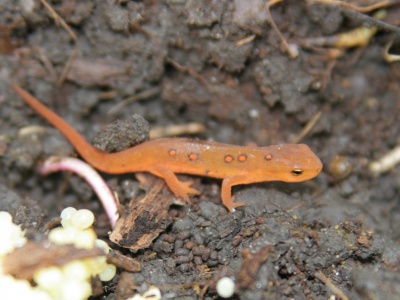Difference between revisions of "Red-spotted Newt"
From WNY Wildlife Wiki
| Line 5: | Line 5: | ||
Facts: | Facts: | ||
| − | They can have up to 21 red spots variable in quantity and location | + | * They can have up to 21 red spots variable in quantity and location |
| − | Aquatic adults normally olive-green but vary from a dark mustard to greenish brown | + | * Aquatic adults normally olive-green but vary from a dark mustard to greenish brown |
| − | Terrestrial stage color varies from bright orange to red-orange | + | * Terrestrial stage color varies from bright orange to red-orange |
| − | Secretes through their skin gland making them distasteful to preditors | + | * Secretes through their skin gland making them distasteful to preditors |
| − | Ponds, lakes, ditches and lazy streams are the best places to find adults | + | * Ponds, lakes, ditches and lazy streams are the best places to find adults |
| − | Efts are found on the forest floor under rocks, logs and leaf litter | + | * Efts are found on the forest floor under rocks, logs and leaf litter |
Revision as of 19:05, 16 January 2011
Latin Name: Notophthalmus viridescens viridescens
Size: 1 3/8 - 4 13/16 in. (Aquatic stage); 1 3/8 - 3 3/8 in.(Terrestrial stage)
Facts:
- They can have up to 21 red spots variable in quantity and location
- Aquatic adults normally olive-green but vary from a dark mustard to greenish brown
- Terrestrial stage color varies from bright orange to red-orange
- Secretes through their skin gland making them distasteful to preditors
- Ponds, lakes, ditches and lazy streams are the best places to find adults
- Efts are found on the forest floor under rocks, logs and leaf litter
